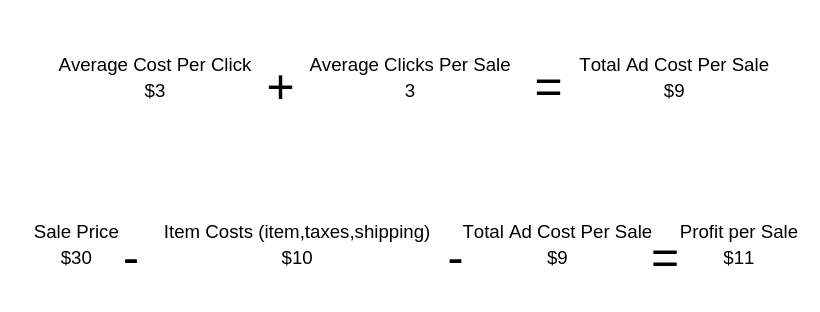
Google and Bing are in the advertising space referred to as PPC marketing. PPC stands for pay per click, this means that you will only pay when someone clicks your ad. The main reason these are such a popular platform is that you have very little wasted spending and you can see and direct exactly where your money is going.
To explain a bit further, you are able to target people who are searching for your exact product or service using keywords that people would type to find you. You can even add negative keywords which helps eliminate any off-topic searches. If you’re a plumber you would want people looking to hire you to repair their leaks, but you wouldn’t want someone looking up how to fix a leak themselves. Adding negatives filters out these irrelevant searches and only puts you in front of the people you pick.
In addition to keywords and not reducing wasted money, you can track where every dollar goes in your campaign. Every click on your ad will have a dollar amount attached to it, based on the ad auction results. You can then use this data, if you’re only wanting website visits, to see how much it will cost to gain a new visitor. If your goal is downloads, store visits, or phone calls you can set up tracking codes on your website and in your ads to see how many people perform those actions. With both of these sets of data, you will be able to get a full cost for someone to download your product or call your business. By knowing this final number you can then see if that amount will still make your product or service profitable. If so, you can then scale your advertising to any amount while still retaining those numbers and always be profitable. The picture below will help for any confusion.

Being able to see your profits aren’t the only benefit, you can also target your ideal customer, as well as, gather data about your ideal customer.
Using audience metrics you can filter down your targeting to only show your ads to a specific gender, age group, income level, or interests.
By running your ads over the course of a few months to a year, you will be collecting enough data from sales to start seeing your ideal customer. This allows you to make very relevant ads to your ideal customer and not having to waste time and money with people outside your ideal customer persona to click on your ads.
The last benefit I’ll mention is re-marketing, this allows you to target all visitors to your website who don’t trigger one of your conversion trackers. This will show your business’ image ads on every website in the ad market that the person visits for 30 days on average, this is a very powerful tool to try and get that second chance at a sale.
how other marketing channels stack up

Now I know what you're thinking, wait, isn't Google and Bing part of this? Well yes, they are, however they are the only ones that utilize keywords to target people. Facebook is the Biggest contender in this area and I have a full write up about the battle below. There are other platforms, mainly all major social media Twitter, Pinterest, Instagram, Snapchat, Linked In, etc. Other ways include Yelp, Foursquare, and Home adviser.
The social media platforms can be utilized for free, however, you typically will need to post daily with engaging content and build a following to get any traction in making it worthwhile. They also have paid ads but those only use the audience targeting to target your ideal customer which casts a very wide net, leaving you with a higher cost for unnecessary clicks or traffic.
The business review sites are free, paid, or even have both depending on the site. These are like posting a billboard where anyone can see and rate you. This isn't a bad option if you choose a popular high traffic site, but can be damaging as people are very quick to rate you low and very slow if at all, to rate you for their great experience.
These types of advertising do work well for the free versions as most people go to these sources to check if a business is active. The paid versions are more beneficial to a limited number of industries and will cost more to find your paying customers than if you used Google or Bing [Facebook case study] [my Facebook case study].

Newspaper ads are a long time tradition since the 1800s, if you wanted to have your business known in the local town you took out an ad in the paper.
This has been diminishing over the past 20 years, as our culture has rapidly advanced our digital footprint.
There are still people who receive a weekly paper, most in the age range of 40+ [source].

Radio Ads started in the early 1900s and became another popular place to advertise your business, as everyone had a radio in their house or later in their cars.
This is a good place to advertise on as over half the number of people who listen to the radio daily are in their cars. This means their ears are focused on the radio and you have anywhere from 5-minutes to hours to share your companies product or service with them.
As this is another good place to advertise, it still comes with its downfalls, mainly the fact you again have to pay a lump sum of money and hope your paying customers are listening. Getting your ads on the top radio shows in town are a huge benefit but also typically come with a proportionate cost.

Towards the mid-1900s, we started moving towards the next hot source to advertise on. Television ads are better than both newspaper and radio as you could now make a flashy visual ad to engage the person viewing.
With the average person watching TV for 4-5 hours daily, you get a good sized window for your ad to be seen by many.
The most recent issue to attack this type of advertising has come in the form of Streaming services like Netflix. As a majority of people who watch TV typically hate sitting through commercials, and once they had an option to eliminate commercials they started to leave cable TV in droves.
This type of advertising, although being flashier than newspaper and radio, still has the same issue with tracking the profitability.

This type of advertising is a very interesting approach, as you can advertise the speech to target people interested in the area of business you are in and have a group where some people in the crowd will actually buy from you.
This is like a live version of Facebook advertising, the main difference is this can more than likely be a free cost, you will just need to put in the leg work to gather people and rent a space.
This can be a good option for local businesses or those on a tight budget. This can also be tracked fairly well using a signup sheet and figuring out the math of how many people converted vs how many attended.

This type of advertising is usually a low cost but is a more quantity over quality, where you're going for a brand awareness campaign.
The hope is by plastering your business name and logo on everyone's door in a 5-mile radius or hanging 10,000 flyers around town you'll be able to catch the eye or stick in someone's mind and gain their business.
This is an option to try but it rarely works as the expected response rate is 1-3%.

This can be a good advertising route for local businesses, as you can advertise at high school games or other events in the city to show yours in the community.
The only downside to this type of advertising is like the rest where you're paying a lump sum to show your ad and hoping the right people are at that event and see your ad.
Its a good move for local businesses but still mainly a company branding campaign and won't see a massive return from it.
THE BOTTOM LINE
After going over all the major ways to advertise your company, none of them had the pinpoint accuracy or the detailed track-ability that Google and Bing ads supply.
There’s a lot higher chance of overspending on people who are uninterested in your product or service with these other methods. You are also not able to see a detailed review of how these marketing campaigns performed, besides getting 10 new calls or sales out of a possible unknown amount of people.
This method doesn’t allow you to see your conversion rate and it will also make it impossible to adjust the ad to improve the number of calls, or sales it brings in.
Now I’m not saying that these other areas are not worth using, they can be for the right industry, or if your company is becoming more known these can serve as a good branding source of advertising.
Request Your Free Consultation
Please find a time below, call or text us anytime for your free consultation. You can also use the “Schedule A Call” button to skip a step and grab a spot on our Calendly calendar.
Office hours are currently Monday – Friday 09:00a – 06:00p CST
We look forward to speaking with you!
~MDM PPC